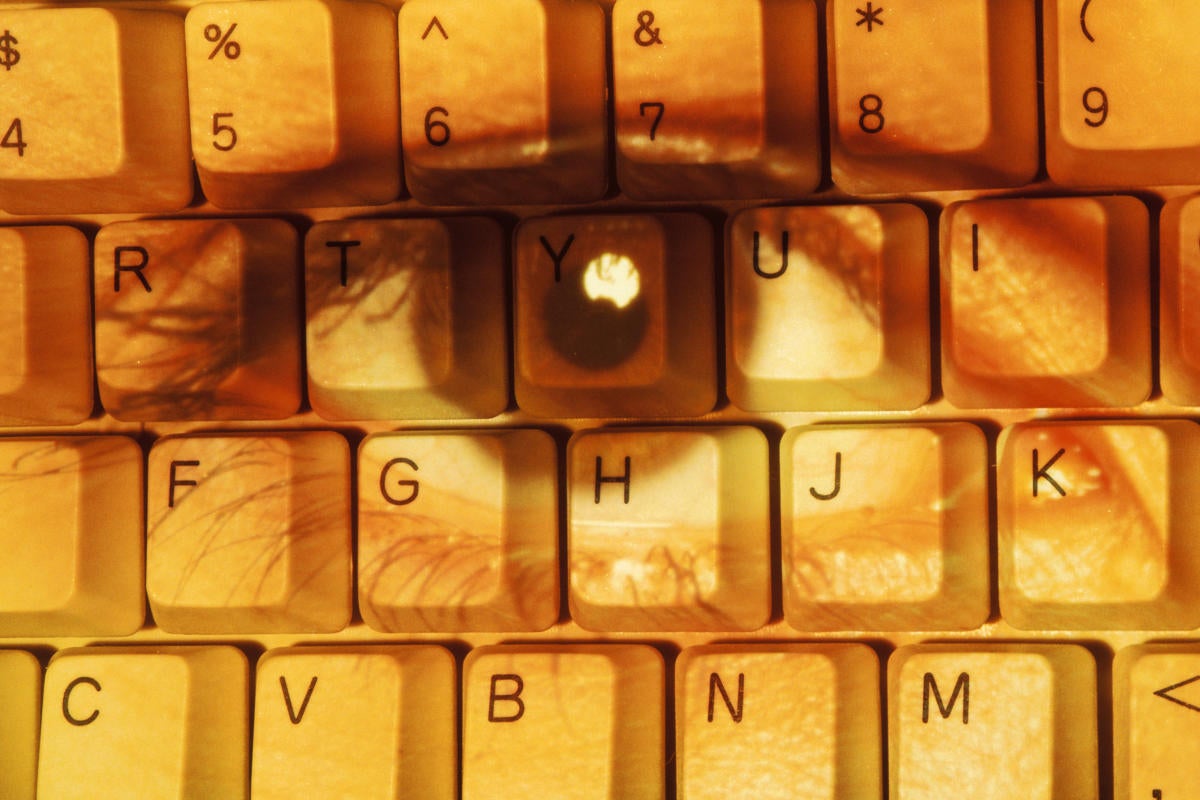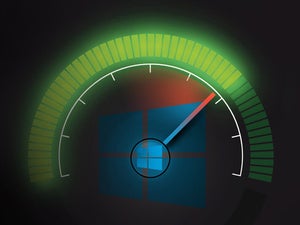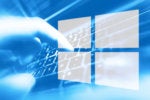There has been some concern that Windows 10 gathers too much private information from users. Whether you think Microsoft's operating system crosses the privacy line or just want to make sure you safeguard as much of your personal life as possible, we're here to help. Here's how to protect your privacy in just a few minutes.
Note: This story has been updated for Windows 10 version 22H2. If you have an earlier release of Windows 10, some things may be different. If you have Windows 11, see "How to protect your privacy in Windows 11."
Turn off ad tracking
At the top of many people's privacy concerns is what data is being gathered about them as they browse the web. That information creates a profile of a person's interests that is used by a variety of companies to target ads.
Windows 10 does this with the use of an advertising ID. The ID doesn't just gather information about you when you browse the web, but also when you use Windows 10 apps. Your advertising ID isn’t synced to other computers, and it operates independently of your Microsoft account, if you’re using one.
You can turn that advertising ID off if you want. Launch the Windows 10 Settings app (by clicking on the Start button at the lower left corner of your screen and then clicking the Settings icon, which looks like a gear) and go to Privacy. You should see "General" highlighted on the left. On the General pane in the main window, you'll see a list of choices under the title "Change privacy options." The first controls the advertising ID.
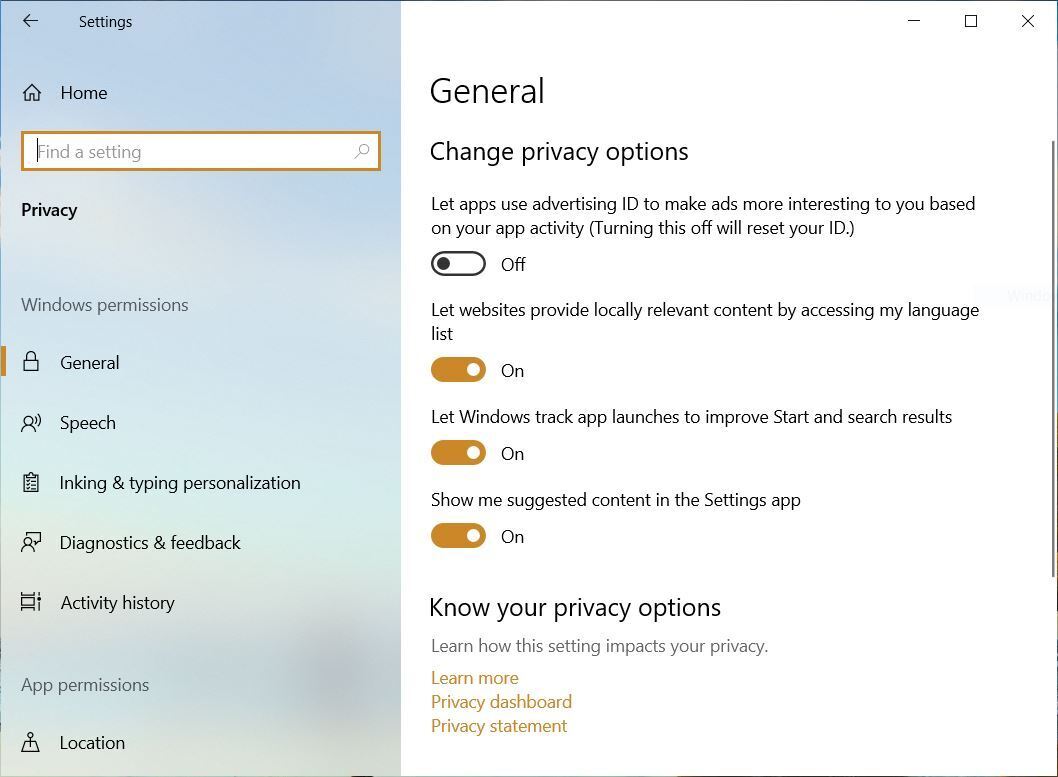 IDG
IDG
You can turn off Windows 10's advertising ID if you want. (Click image to enlarge it.)
Move the slider from On to Off. You'll still get ads delivered to you, but they'll be generic ones rather than targeted ones, and your interests won't be tracked.
To make absolutely sure you're not tracked online when you use Windows 10, and to turn off any other ways Microsoft will use information about you to target ads, head to the Ad Settings section of Microsoft's Privacy Dashboard. Sign into your Microsoft account at the top right of the page.
Then go to the "See ads that interest you" section at the top of the page and move the slider from On to Off.
Turn off location tracking
Wherever you go, Windows 10 knows you're there. Some people don't mind this, because it helps the operating system give you relevant information, such as your local weather, what restaurants are nearby and so on. But if you don't want Windows 10 to track your location, you can tell it to stop.
Launch the Settings app and go to Privacy > Location. Underneath "Allow access to location on this device," click Change and, on the screen that appears, move the slider from On to Off. Doing that turns off all location tracking for every user on the PC.
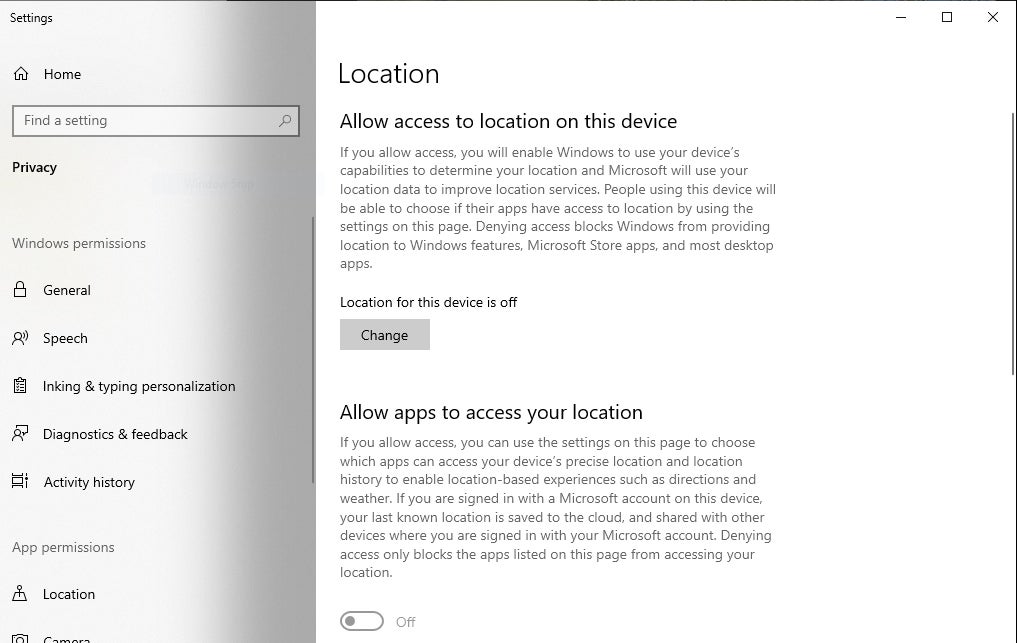 IDG
IDG
Clicking the Change button lets you turn location tracking on or off for every user on the Windows 10 device. (Click image to enlarge it.)
This doesn't have to be all-or-nothing affair — you can turn off location tracking on an app-by-app basis. If you want your location to be used only for some apps and not others, make sure location tracking is turned on, then scroll down to the "Choose which apps can use your precise location" section. You'll see a list of every Windows 10 app that can use your location. Move the slider to On for the apps you want to allow to use your location — for example, Weather or Maps — and to Off for the apps you don't.
That doesn’t cover desktop apps, though. So after you turn on location tracking, go to “Allow desktop apps to access your location” and turn the slider to On. When you do that, a list of desktop apps that use location tracking appears. Move the slider to On for each of the apps you want to use your location and Off for each app you don’t.
When you turn off location tracking, Windows 10 will still keep a record of your past location history. To clear your location history, go to the Privacy Dashboard, scroll down to the Location Activity section, click View and Clear Location Activity, and delete all or some of your location history.
There's a lot more you can do to protect your privacy when you're there. For details, see "Use Microsoft's Privacy Dashboard" below.
Turn off Timeline
Timeline is a Windows 10 feature that lets you review and then resume activities and open files you've started on your Windows 10 PC, as well as any other Windows PCs and devices you have. So, for example, you can switch between a desktop and a laptop, and from each machine resume activities you've started on either PC.
In order to do that, Windows needs to gather information about all your activities on each of your machines. If that worries you, it's easy to turn Timeline off. To do it, go to Settings > Privacy > Activity history and uncheck the box next to Store my activity history on this device.
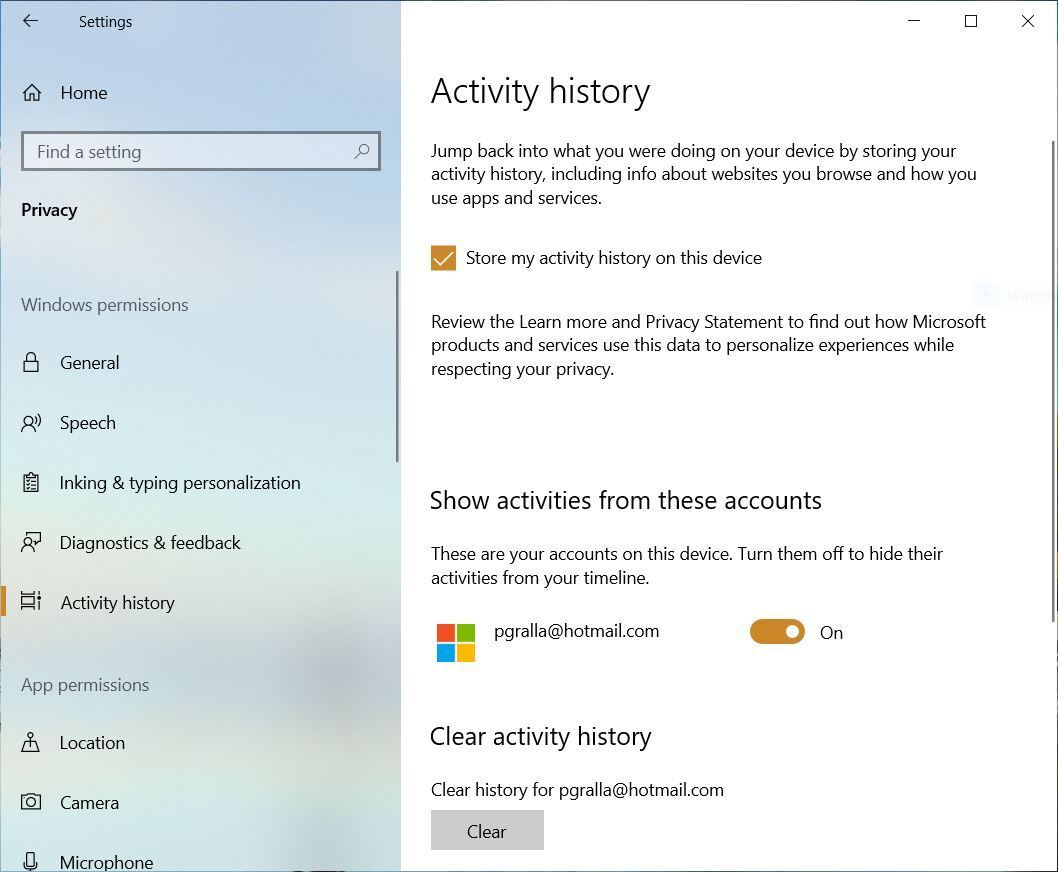 IDG
IDG
Here's how to turn off Timeline so that Microsoft doesn't gather information about your activities on your PC. (Click image to enlarge it.)
At that point, Windows 10 no longer gathers information about your activities. However, it still keeps information about your old activities and shows them in your Timeline on all your PCs. To get rid of that old information, go down to the "Clear activity history" section of the screen and click Clear.
Note that you'll have to take these steps on all of your PCs to turn off the tracking of your activities.
Curb Cortana
Cortana is a somewhat useful digital assistant, but there's a tradeoff in using it: To do its job well, it needs to know things about you such as your home location, place of work, and the times and route you take to commute there. If you're worried it will invade your privacy by doing that, there are a few things you can do to limit the information Cortana gathers about you. But there's some information you'll have to share with Cortana if you want to use the assistant at all.
Start by opening Cortana settings: Click the Cortana icon to the right of the Windows search box (it's a circle), then click the three-dot icon in the upper left of the screen and select the Settings (gear) icon that appears in the pane. Then click Privacy. A panel appears that lets you, to a limited extent, limit the information Cortana gathers about you.
 IDG
IDG
Here's the central location for handling privacy in Cortana, but there's not a lot you can do to limit its privacy gathering if you want to continue to use it. (Click image to enlarge it.)
Click Revoke permission and sign out, and you'll be signed out of Cortana, your chat history will be cleared, and Cortana won't track information such as your location or connect with your calendar, email, contacts, and other apps and services. But you won't be able to use Cortana, either. The next time you sign in, Cortana will once again track you and connect with all those services.
If you only want to clear your chat history but remain signed into Cortana, click Clear in the chat history section. Your chat history will be deleted, but once you start using Cortana, you'll once again build up a chat history.
Note that the “Microsoft Privacy dashboard” section of Cortana’s settings is outdated. It brings you to the Microsoft Privacy Dashboard, but the Dashboard no longer lets you clear Cortana data.
Ditch a Microsoft account for a local account
When you use your Microsoft account to log into Windows 10, you're able to sync your settings with all Windows devices. So, for example, when you make changes to your settings on a desktop PC, those changes will also be made on your laptop the next time you log in.
But maybe you don't want Microsoft to store that information about you. And maybe you want to cut your ties as much as possible to anything Microsoft stores about you. If that's the case, your best bet is to stop using your Microsoft account and instead use a local account.
To do it, go to Settings > Accounts > Family & other users. Then click Add someone else to this PC. From the screen that appears, select I don't have this person's sign-in information. On the next page, select Add a user without a Microsoft account and follow the instructions to create and use a local account.
Keep in mind that when you do this, you won't be able to use Microsoft's OneDrive storage or download and install for-pay apps from the Microsoft Store. You can, however, download and install free apps from the Microsoft Store.
Change your app permissions
Windows apps have the potential to invade your privacy — they can have access to your camera, microphone, location, pictures and videos.
But you can decide, in a very granular way, what kind of access each app can have.
To do this, go to Settings > Apps. Below "Apps & features" you'll see a list of your installed apps. Click the app whose permissions you want to control, then click Advanced options and set the app's permissions by toggling them either on or off.
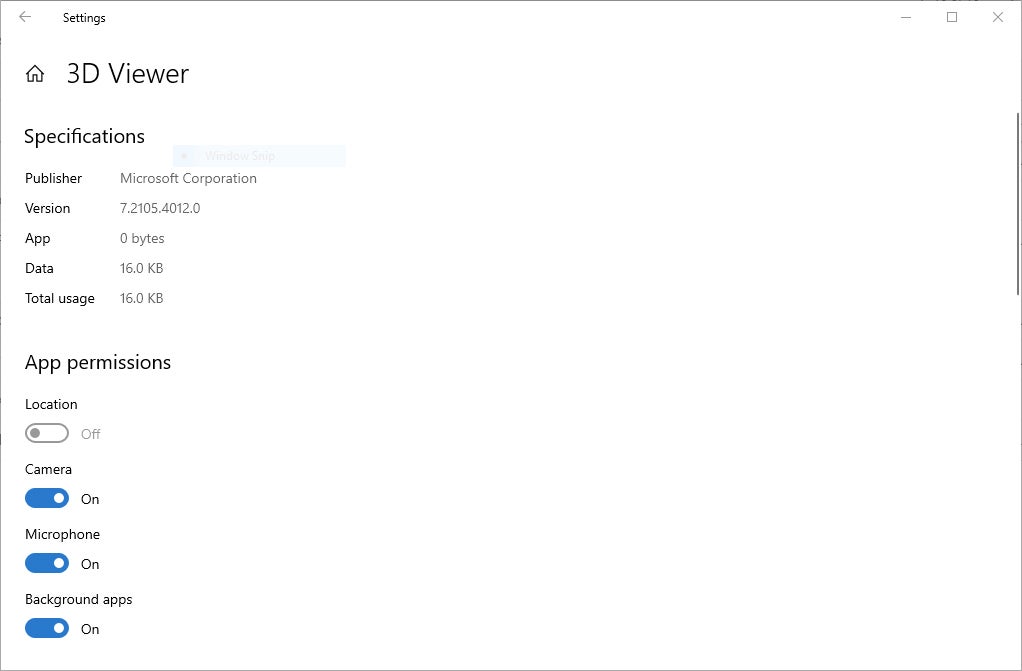 IDG
IDG
Setting permissions for Microsoft’s 3D Viewer app. (Click image to enlarge it.)
Note, though, that not all apps have an "Advanced options" link. And of those that do, not all let you customize your app permissions.
However, there's another way to change app permissions. To do it, go to Settings > Privacy and look under the "App permissions" section on the left-hand side of the page. You'll see a list of all of Windows' hardware, capabilities and features that apps can access if they're given permission — location, camera, microphone, notifications, account info, contacts and so on.
Click any of the listed items — for example, Microphone. At the top of the page that appears, you can turn off access to the microphone for all apps. Below that you'll see a listing of all the apps with access to the microphone, where you can control access on an app-by-app basis. Any app with access has a slider that is set to On. To stop any app from having access, move the slider to Off.
Control and delete diagnostic data
As you use Windows 10, data is gathered about your hardware and what you do when you use Windows. Microsoft says that it collects this data as a way to continually improve Windows and to offer you customized advice on how to best use Windows.
That makes plenty of people uncomfortable. If you're one of them, you can to a certain extent control what kind of diagnostic data is gathered about you. To do it, head to Settings > Privacy > Diagnostics & Feedback. In the "Diagnostic data" section, you can choose between two levels of diagnostic data to be gathered. Note that there's no way to stop Microsoft from gathering diagnostic data entirely. Here are your two choices:
- Required diagnostic data: This sends information to Microsoft "about your device, its settings and capabilities, and whether it is performing properly." If you're worried about your privacy, this is the setting to choose.
- Optional diagnostic data: This sends the whole nine yards to Microsoft: It will send info about the websites you browse and how you use apps and features, plus additional info about device health, device usage, and enhanced error reporting." It also sends along required diagnostic data. If you're worried about your privacy, don't make this choice.
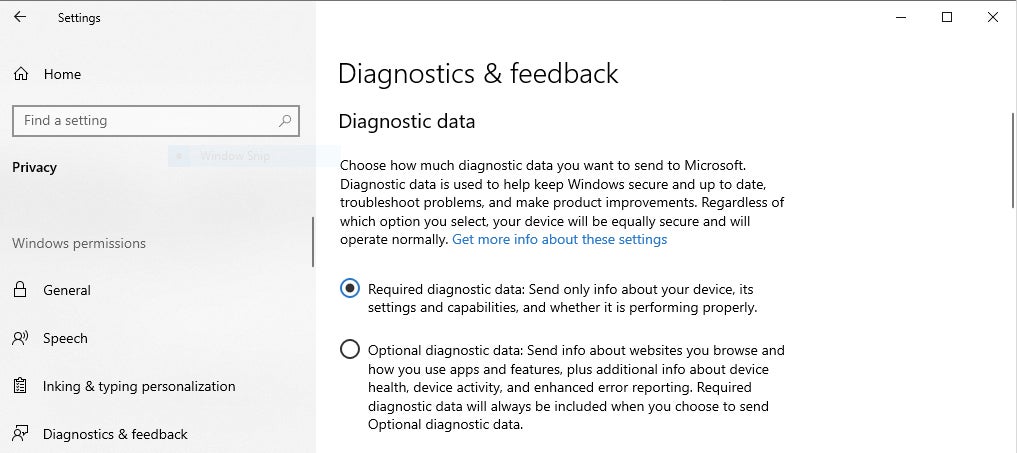 IDG
IDG
Go here to control what diagnostic data Windows 10 gathers. (Click image to enlarge it.)
Next, scroll down to the "Tailored experiences" section and move the slider to Off. This won't affect the data Microsoft gathers, but it will turn off targeted ads and tips that are based on that information. So while it won't enhance your privacy, you'll at least cut down on the annoyance factor.
Now scroll a bit further down and in the "Delete diagnostic data" section, click Delete. That will delete all the diagnostic data Microsoft has gathered about you. However, after you delete it, Microsoft will start gathering the data again.
Finally on this screen, consider scrolling up to the "Improve inking and typing" section and moving the slider to Off. That will stop Windows 10 from sending to Microsoft the words you input using the keyboard and inking.
One final note about diagnostic data. You may have heard about a tool Microsoft has been hyping, called the Diagnostic Data Viewer, which you can download from the Microsoft Store. Microsoft claims it lets you see exactly what kind of diagnostic data Microsoft gathers about you. Don't believe it. It's something only a programmer could love — or understand. You won't be able to use it to clearly see the diagnostic data Microsoft collects. Instead, you'll scroll or search through incomprehensible headings such as "TelClientSynthetic.PdcNetworkActivation_4" and "Microsoft.Windows.App.Browser.IEFrameProcessAttached" with no explanation of what it means. Click any heading, and you'll find even more incomprehensible data.
Use Microsoft's Privacy Dashboard
Microsoft has built an excellent, little-known web tool called the Privacy Dashboard that lets you track and delete a lot of information Microsoft gathers about you. As covered earlier in this story, here you can turn off ad targeting. You can also view and delete your browsing history, search history, location activity, voice activity, media activity, and more.
(Note that for your browsing and search history, it only tracks your activity when you use Microsoft Edge or Internet Explorer. It doesn't track data when you use other browsers, like Chrome or Firefox. And it only tracks your location history when you're using Microsoft devices, not those that use iOS or Android.)
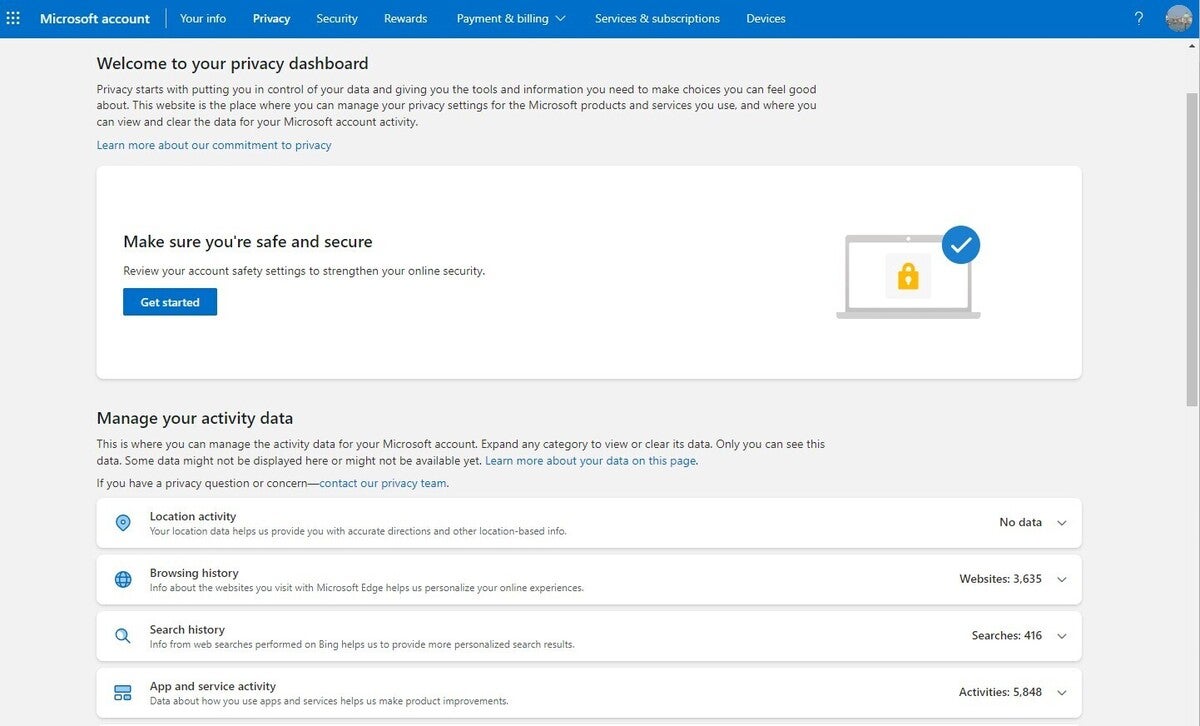 IDG
IDG
Microsoft's little-known Privacy Dashboard is a great place to delete much of the information Microsoft gathers about you. (Click image to enlarge it.)
To use it, head to the information you want to view and clear, then click the appropriate link — for example, View and delete browser history in Microsoft Edge. Note that in some instances, you won’t have full control over deleting and managing data.
In the dashboard you can also customize privacy settings for other Microsoft products, including Xbox, Office/Microsoft 365, and Microsoft Teams. Scroll to the "Privacy settings in our products" section and click the product you're interested in.
Get granular in the Settings app
All this shouldn't take that long and will do a great deal to protect your privacy. If you want to dig even deeper into privacy protections, launch the Settings app and click Privacy. You'll see the same General pane that we covered in the first tip in this story. Below the switch to turn off your advertising ID are three more privacy settings you can disable:
- Language list: The list of languages you have enabled on your machine is your own business.
- App launches: This is used to build the "Most used" list on the Start menu and influences search result order — likely not a must-have for the privacy minded.
- Suggested content: This is used, in Microsoft’s words, to “suggest new content and apps you might find interesting.” Trust me, it’s unlikely you’ll find them interesting.
Turn all three of these off to further protect your privacy.
And there's a lot more beyond the General pane. On the left-hand side of the screen, you'll see additional areas where you can get even more granular about privacy — for example, in the "Windows permissions" section you can change your global privacy options for things such as speech recognition and inking. And here's where you'll get access to all app permissions, as outlined earlier in this article.
Tips for the truly paranoid
If you want to take privacy even further, there are a few more things you can do.
Stop using OneDrive
If you don't like the idea of syncing your data to Microsoft's OneDrive cloud storage service, you can stop using it. (There's no way to uninstall it.) Right-click the OneDrive icon on the notification tray at the bottom right of the Windows desktop and select Settings from the menu that pops open. In the OneDrive Settings window, go to the Account tab, then click the Unlink this PC button. Next, click the Sync and backup tab and uncheck Start OneDrive when I sign in to Windows.
 IDG
IDG
Switch the slider next to "Start OneDrive when I sign into Windows" to Off. (Click image to enlarge it.)
Don't sync Windows settings across devices
In addition, you can say no to syncing your Windows settings among different devices. When you sync your settings, the way you’ve customized and set up Windows 10 will be synced to Microsoft’s servers. If you want to turn it off, go to Settings > Accounts > Sync your settings and turn off the switch under Sync settings.
Turn off app diagnostics
Changing this setting isn't a particularly big privacy-enhancer, but if you're a real privacy fiend, every bit helps. It doesn't affect desktop apps like Word or Excel, and instead targets built-in Windows apps and the apps you download from the Microsoft Store. Turning off app diagnostics stops any of those apps from getting details about other apps — things such as their internal names, package names, the user name of the person running the app, and techie details such as memory usage. Developers use this information all the time, but your garden-variety apps shouldn't need any of it.
To turn it off, select Settings > Privacy > App diagnostics, and in the "Allow access to app diagnostic info on this device" section, click Change. When a slider appears, move it to Off.
 IDG
IDG
Turn off app diagnostics to prevent built-in Windows apps and Microsoft Store apps from getting details about other apps. (Click image to enlarge it.)
Don't share Windows updates
Finally, you can change the way Windows updates. In Settings > Update & Security > Delivery Optimization, turn off the switch next to Allow downloads from other PCs. When turned on, this function lets your Windows 10 system share its update files with other Windows 10 computers on the internet through peer-to-peer distribution.
These steps can take you a long way towards making sure that Windows 10 doesn't cross the line into gathering data you'd prefer remain private.
This article was originally published in January 2016 and most recently updated in November 2022.
More privacy tips:
- Online privacy: Best browsers, settings, and tips
- How to stay as private as possible on the Mac
- The ultimate guide to privacy on Android
- How to stay as private as possible on Apple’s iPad and iPhone
- How to go incognito in Chrome, Edge, Firefox and Safari






